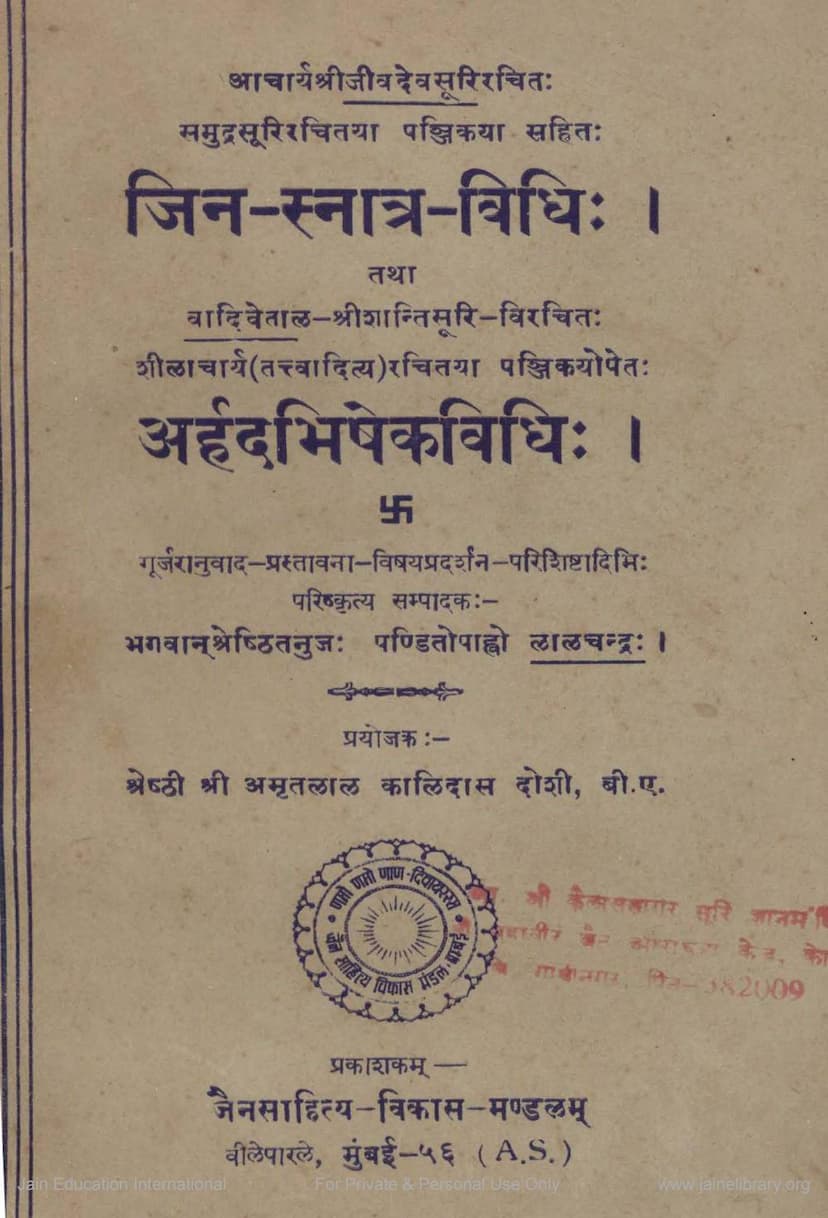Jina Snatra Vidhi
Added to library: September 2, 2025

Summary
This Jain text, titled "Jina Snatra Vidhi" (also incorporating "Arhad Abhishek Vidhi"), is a compilation of ancient Jain rituals and commentaries related to the ceremonial bathing and anointing of Jina (Tirthankara) images. Here's a comprehensive summary based on the provided pages:
Core Content:
The book contains two primary texts:
- Jina Snatra Vidhi (जिन-स्नात्र-विधि): Authored by Acharya Jivdevsuri (आचार्यश्रीजीवदेवसूरि). This text is in Prakrit and consists of 54 verses.
- Arhad Abhishek Vidhi (अर्हदभिषेकविधि): Authored by Vadivetāl Śāntisūri (वादिवेताल-श्रीशान्तिसूरि) and also known as Jina Abhishek. This text is in Sanskrit and comprises 98 verses divided into five sections (parvas).
Both original texts are accompanied by ancient Sanskrit commentaries (panjikas):
- The Jina Snatra Vidhi has a panjika by Samudrasūri (समुद्रसूरि).
- The Arhad Abhishek Vidhi has a panjika by Shīlāchārya (तत्त्वादित्य) (शीलाचार्य (तत्त्वादित्य)).
Key Features and Contributors:
- Editor and Translator: Pandit Lalchandra Bhagwan Shresthi (पण्डितोपाह्वो लालचन्द्रः), who also holds the title "Jain Pandit," meticulously edited and translated these ancient works. He enriched the publication with a Gujarati translation, introduction, exposition of the subject matter, and appendices.
- Publisher: Jain Sahitya Vikas Mandal (जैनसाहित्य-विकास-मण्डलम्), Vile Parle, Mumbai.
- Sponsor: Seth Shri Amritlal Kalidas Doshi, B.A. (श्रेष्ठी श्री अमृतलाल कालिदास दोशी, बी.ए.).
- Publication Details: The first edition was published in Vikram Samvat 2021 (1965 CE) with 500 copies.
Introduction and Context (from the Preface and Editorial Notes):
- The publication aims to shed light on ancient rituals, particularly the "snatra" (bathing) ceremony, with detailed descriptions and clarifications for various doubts.
- The editor highlights the significance of these texts, noting that they are over a thousand years old.
- Manuscript Source: A crucial aspect is the reliance on a palm-leaf manuscript of the Jina Snatra Vidhi, found in the Jain Gyan Mandir in Chhani (Vadodara). This manuscript, dating back approximately seven hundred years (estimated to be from the 14th century CE), was carefully transcribed and is described in detail. It contains verses and notations in Devanagari script.
- Dating of Authors:
- Acharya Jivdevsuri: Based on references in the works of Mahakavi Dhanpal (11th century CE) and Lakshman Gani (12th century CE), Acharya Jivdevsuri is placed prior to the 11th century CE, making his Prakrit composition potentially over a thousand years old.
- Vadivetāl Śāntisūri: His work, the Arhad Abhishek Vidhi, is known to have a Sanskrit panjika by Shīlāchārya. Shīlāchārya is identified as Tatvāditya and is believed to have lived in the 10th century CE. This implies that Vadivetāl Śāntisūri's work predates the 10th century CE, or there might be a different Shīlāchārya involved. The editor notes that Vadivetāl is associated with a Shāntisūri, and references from Ratanashekharasuri (15th century CE) also mention verses from the Arhad Abhishek Vidhi attributed to Shāntisūri. The editor also explores the possibility of identifying this Vadivetāl Shāntisūri with a Gandharva Vadivetāl Shāntisūri from the 8th-9th century CE.
- Importance of Dhavalpuri: The panjika for the Jina Snatra Vidhi was composed in Dhavalpuri, identified as modern-day Dholka in Gujarat. The preface extensively details the historical and religious significance of Dhavalpuri during various periods, highlighting its role as a center of Jain learning and activity.
- Comparative Study: The editor also compares the content of these texts with other known Jain works and mentions the publication of the Arhad Abhishek Vidhi in another journal.
Content of the Rituals (Arhad Abhishek Vidhi - summarized from table of contents and verse summaries):
The Arhad Abhishek Vidhi is presented in five parts, detailing the ritualistic bathing and worship of the Jina image. The content covers:
- First Part: Introduction, the auspiciousness of the Jina bath, the significance of materials used, the results of the ritual, remembrance of divine abhishek on Mount Meru, and the enthusiasm of celestial beings during the Jina's birth.
- Second Part: Setting up the Jina image on a sacred altar, the role of the Shravak (lay follower) in the ritual, the invocation of various deities (Digpalas) and their offerings.
- Third Part: Descriptions of the Jina's form, the use of perfumes, flowers, and sacred water from various rivers and divine sources.
- Fourth Part: The use of medicinal herbs, sandalwood paste, kumkum (vermilion), and tilak. The significance of offering flowers and the philosophical debate regarding the necessity of external adornments for a Vitaraga (one devoid of passions).
- Fifth Part: The offering of various grains, fruits, sweets, and balis (offerings). The performance of Aarti (waving of lamps), the significance of the water streams, the ritual of waving salt (lavana-vatarana), invoking auspicious sounds and chanting. The ritual also includes the proper procedure for the bathing of the Jina image, the worship of celestial beings, and offerings to planetary deities (Navagrahas) for appeasing their influence.
Purpose and Significance:
This text serves as a guide for performing the Jina Snana (bathing) and Abhishek (anointing) rituals, which are integral to Jain worship. It provides the scriptural basis, methodologies, and philosophical underpinnings of these ceremonies, aiming to foster devotion and spiritual merit in the practitioner. The meticulous effort in preserving and presenting these ancient texts highlights their value in understanding the rich liturgical traditions of Jainism.